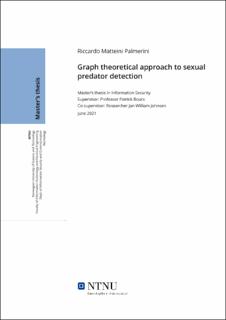| dc.contributor.advisor | Bours, Patrick | |
| dc.contributor.advisor | Johnsen, Jan William | |
| dc.contributor.author | Matteini Palmerini, Riccardo | |
| dc.date.accessioned | 2021-09-23T19:17:05Z | |
| dc.date.available | 2021-09-23T19:17:05Z | |
| dc.date.issued | 2021 | |
| dc.identifier | no.ntnu:inspera:80310926:71716233 | |
| dc.identifier.uri | https://hdl.handle.net/11250/2781226 | |
| dc.description.abstract | Med teknologispredningen er vi i stand til å komme i kontakt med venner langt unna så vel som ukjente personer. Bak skjermer kan personer med onde hensikter skjule identiteten deres og handle i frihet. Overgripere tar mindre risiko når de kommuniserer med mindreårige via Internettet enn om de samme handlingene ble gjort i det virkelige liv. Den kriminelle aktiviteten fra overgripere støttes av fremveksten av elektroniske plattformer som bruk av offentlige samtalerom.
Denne avhandlingen søker å bruke grafteoretiske funksjoner og sentralitetsmålinger for å fremheve mulige indikatorer som detekterer seksulle overgripere. Spesifikt er denne avhandlingen ikke interessert i datautvinning av samtale logger, men fokuserer på testing av funksjoner som antall kanter og antall utvekslede meldinger for å finne unormal oppførsel i nettverk.
Avhandlingen analyserer hvordan sentralitet kan brukes til å oppdage unormale noder i nettverk. Avhandlingen bidrar til å fremheve merkelig oppførsel hos brukere i offentlige samtalerom uten å se innholdet i samtalene. | |
| dc.description.abstract | With the spreading of the technology, we are able to get in touch with distant friends as well as unknown persons. Behind a monitor, evil presences can hide their identity and act in freedom. Sexual predators in the Internet are able to communicate with minors by risking less than in the real life. Their activity is supported by the advent of online platforms characterized by public chat rooms.
The thesis seeks to use graph theory features and centrality measures in order to highlight possible indicators for the cyber sexual predators detection. More specifically, the study is not interested on mining chat logs, but rather it focuses on testing features like the number of edges and the number of messages exchanged to find out abnormal behaviours within the network.
The thesis analyses how the centrality measures can be used to detect abnormal nodes within a network. The thesis contributions is trying to determine a way for highlight strange behaviours of users in public chat rooms without looking at content of the conversations. | |
| dc.language | eng | |
| dc.publisher | NTNU | |
| dc.title | Graph theoretical approach to sexual predator detection | |
| dc.type | Master thesis | |
